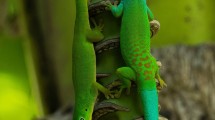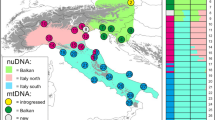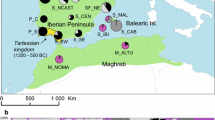Abstract
The rapid range southward expansion of the periwinkle Littorina littorea from the Canadian maritimes has fueled a long-running debate over whether this species was introduced to North America by human activity. A reappraisal of the mitochondrial DNA sequence evidence finds considerable endemic allelic diversity in the American population. The degree of endemic genetic diversity is higher than expected from human-mediated colonization, but not so much to suggest that it survived the last glacial maximum in America. Coalescent estimates of population divergence agree that colonization of America preceded European contact. A reappraisal of the ITS nuclear sequence data finds extensive recombination. Taking this recombination into account strengthens the genetic case against human-mediated introduction. Finally, a reappraisal of conflicting allozyme studies from the 1970’s supports a claim of limited divergence between American and European populations. This is consistent with post-glacial colonization, but the allozyme data cannot distinguish between natural or human-mediated colonization. Taken as a whole, the DNA sequence data supports the many sub-fossil reports of an American L. littorea population in the Canadian maritimes that preceded even the first visits by the Vikings.
Similar content being viewed by others
References
Brenchley GA, Carlton JT (1983). Competitive displacement of native mud snails by introduced periwinkles in the New England intertidal zone: Bio. Bull. 165:543–558
Berger EM (1977) Gene-enzyme variation in three sympatric species of Littorina. II. The Roscoff population, with a note on the origin of North American L. littorea. Biological Bulletin153:255–264
Bird JB (1968) Littorina littorea: occurrence in a northern Newfoundland beach terrace, predating Norse settlements. Science 159:114
Carlton JT (1982) The historical biogeography of Littorina littorea on the Atlantic coast of North America, and implications for the interpretation of the structure of New England intertidal communities. Malacological Review 15:146
Carlton JT (1992) Introduced marine and estuarine mollusks of North America: an end-of-the- 20th-century perspective. Journal of Shellfish Research 11:489–505
Chapman JW, JT Carlton, MR Bellinger, AMH Blakeslee (2007) Premature Refutation of a Human-Mediated Marine Species Introduction: The Case History of the Marine Snail Littorina littorea in the Northwestern Atlantic. Biological Invasions
Clarke AH (1963) Littorina littorea as an indicator of Norse settlements. Science 142:1022
Clarke AH (1971) Littorina littorea, native or introduced. The Biologist 53:160–162
Clarke AH, Erskine JS (1961) Pre-Columbian Littorina littorea in Nova Scotia, Science 134:393
Ganong WF (1886) Is Littorina littorea introduced or indigenous. American Naturalist 20:931–940
Hey J, Nielsen R (2004) Multilocus methods for estimating population sizes, migration rates and divergence time, with applications to the divergence of Drosophila pseudoobscura and D. persimilis. Genetics 167:747–760
Johannesson K (1992) Genetic variability and large scale differentiation in two species of littorinid gastropods with planktotrophic development, Littorina littorea (L.) and Melarhaphe (Littorina) neritoides (L.) (Prosobranchia: Littorinacea), with notes on a mass occurrence of M.␣neritoides in Sweden. Biological Journal of the Linnaean Society 47:285–299
Leifsdóttirr OE, Símonarson LA (2002) The mesogastropod Littorina littorea (Linné, 1758) in Iceland: palaeobiogeography and migration. Cainozoic Research 1:2–12
Morris SR (1979) Genetic variation in the genus Littorina, Ph.D., University College of Swansea, Wales, UK
Nei M, Li W-H (1979) Mathematical model for studying genetic variation in terms of restriction endonucleases. Proceedings of the National Academy of Sciences 76:5269–5273
Nielsen R, Wakeley J (2001) Distinguishing migration from isolation: a Markov chain Monte Carlo approach. Genetics 1958:885
Reid DG (1996) Systematics and evolution of Littorina. The Ray Society, The Dorset Press, Dorchester, Dorset, England, pp 463
Rozas J., Rozas R (1999) DnaSP, Version 3: an integrated program for molecular population genetics and molecular evolution analysis. Bioinformatics 15:174–175
Vermeij GJ (1982) Environmental change and the evolutionary history of the periwinkle Littorina littorea in North America. Evolution 36:561– 580
Wares JP, Goldwater S, Kong BY, Cunningham CW (2002) Refuting a controversial case of a human-mediated marine species introduction. Ecology Letters 5:577–884
Wagner FJE (1977) Palaeoecology of marine Pleistocene Mollusca, Nova Scotia. Canadian Journal of Earth Science 14:1305
Wares JP, Cunningham CW (2001) Phylogeography and historical ecology of the North Atlantic intertidal. Evolution 55:2455–2469
Author information
Authors and Affiliations
Corresponding author
Rights and permissions
About this article
Cite this article
Cunningham, C.W. How to Use Genetic Data to Distinguish Between Natural and Human-Mediated Introduction of Littorina littorea to North America. Biol Invasions 10, 1–6 (2008). https://doi.org/10.1007/s10530-007-9099-8
Received:
Accepted:
Published:
Issue Date:
DOI: https://doi.org/10.1007/s10530-007-9099-8




